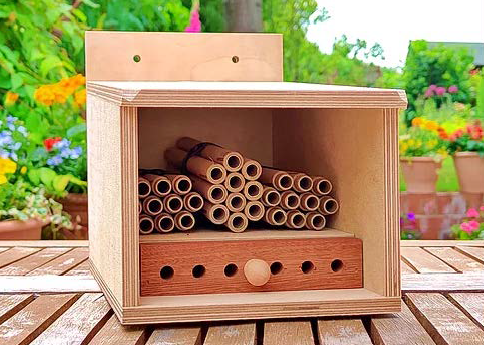Bumble Bees and other beneficial insects
Talk about Wild Tree Bumble Bees by Clive Hill
Bumble bees are important pollinators for fruit and vegetables and of great importance to allotments.
Clive presented the topic, covering many areas regarding wild bees including the variety, their habitat & the best plants & flowers to grow to attract them, along with details of those that do not attract bees.
If anyone would like to know more about bumble bees please go to the website: www.bumblebeeconservation.org
The links below supply further information on this topic, thanks to Bumble Bee Comservation Society.
gallery/Gardening for Bumble Bees.pdf
gallery/Guide to Bumble Bees and insects that are similar .pdf
Bees - our helpers in the Garden, Allotment and Field, a personal exprience by Maren Talbot
The Red Mason Bee (Osmia bicornis) (Pictures courtesy of MasonBee.co.uk)
As an allotment gardener of many years, I have always been keen to work with nature and encourage any beastie that’s beneficial to my endeavours. The honeybee is, of course, the one we all know and love, until we get stung, which can have serious consequences.There is a whole world of wild bees, which are less well known, my favourites are the Red Mason Bees. These are gentle, non-aggressive solitary bees that make their nests in hollow spaces rather than in hives. They pollinate far more efficiently and effectively than honeybees, and they happily work alongside their nectar-gathering counterparts. In a nutshell:
• They emerge from cocoons.
• They nest in hollow spaces.
• They don't sting.
Sadly, the number of red mason bees in the wild is declining and they need our help. It is vital to our future that we safeguard their existence.
By creating bee-friendly habitats in our gardens, allotments and green spaces, and by taking an active role in helping bees fight disease and predation, we can begin to help mitigate some of the challenges facing them today. This is how I do it:


Accommodation: No need for a beehive with all the equipment, knowledge, cost, insurance, maintenance, risks etc. involved in beekeeping. These bees look after themselves, I have assembled a little ‘village’ of bee hotels on an outdoor table on my plot. In the spring, I obtain cocoons containing bee babies. These are placed in a hatching box and the bees do the rest. Once they are hatched, they fly around pollinating everything in their path; at night they sleep, often near their brood sites to protect them.
They do need a little water, which I provide in a shallow plastic saucer filled with stones and gravel, so that they can walk to the water’s edge and drink in comfort. The water also helps them make mud with which they seal their nesting tubes. That’s all they need and, of course, a lot of flowering plants to feed them. I add variation to their diet by growing flowers, mainly with single blooms. These are more attractive to bees than double flowers, where it’s difficult for them to find the pollen.
When the season comes to an end, they lay eggs in cardboard nesting tubes, which I provide in the bee hotels, and then they disappear. It is quite easy to extract the cocoons from the nesting tubes, clean and store them over the winter. Since I started this, my harvest of filled tubes has increased year by year. More bees means higher yields of crop all year round, especialy on all nearby fruit trees and bushes - this is so satisfying.


Maren Talbot
MAA Treasurer & Seed Secretary

